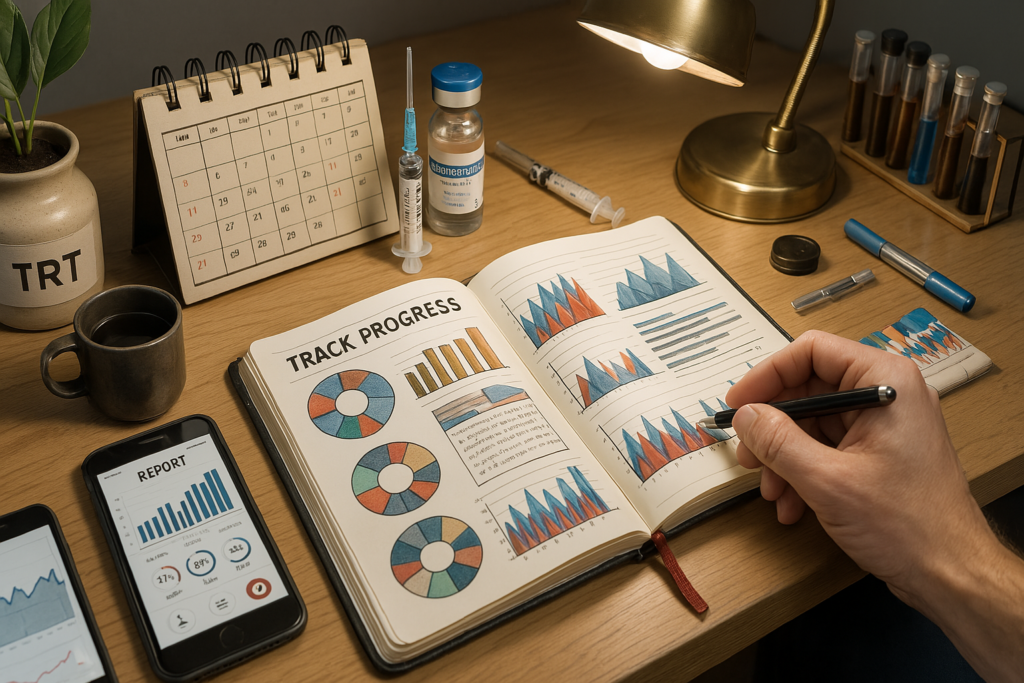How to Track Your Progress on TRT for Best Results

Last Updated On March 31, 2025
Starting Testosterone Replacement Therapy (TRT) is just the beginning – tracking your progress is essential for ensuring long-term success. By keeping detailed records of your symptoms, dosages, and bloodwork, you can fine-tune your protocol for optimal results. Here’s how to track your TRT journey effectively.
Get our Free Tracking Templates for effective tracking.
1. Keep a Symptom Log
Your body’s response to TRT isn’t just about lab numbers – it’s also about how you feel. Logging your symptoms helps you identify patterns and make informed adjustments.
What to Track:
- Energy levels throughout the day.
- Mood and mental clarity.
- Libido and sexual function.
- Sleep quality.
- Physical performance (e.g., strength, endurance).
How to Log It:
- Use a journal, spreadsheet, or note-taking app to record symptoms daily or weekly.
- Rate key symptoms on a scale (e.g. 1-10) to track improvements over time.
Pro Tip: Be consistent with logging to notice trends and changes, especially after adjusting your protocol.
2. Create a Dosage and Injection Schedule
Consistency in your TRT protocol is crucial. Keeping a clear schedule for dosages and injections ensures you never miss a dose or inject incorrectly.
How to Stay Organized:
- Use a calendar app or set reminders on your phone for injection days.
- Record the date, time, dose, and injection site for each administration.
- Rotate injection sites (e.g., left glute, right thigh) to prevent scar tissue buildup.
Pro Tip: Include your injection method (IM or SubQ) in your logs to evaluate which method works best for you.
3. Schedule Regular Blood Tests
Bloodwork is the most reliable way to monitor your progress and adjust your protocol. A consistent schedule helps you measure the effectiveness of TRT over time.
Suggested Blood Test Schedule:
- Baseline Tests: Before starting TRT, get a comprehensive panel that includes Total Testosterone, Free Testosterone, Estradiol, SHBG, CBC, and liver/kidney function.
- 4-6 Weeks Post-Start: Check how your body is responding and make any necessary adjustments.
- Every 3-6 Months: Monitor long-term progress and catch potential issues (e.g. high hematocrit levels).
Pro Tip: Stick to the same lab for consistency in results.
4. Use a Progress-Tracking Template
A progress tracker consolidates all your information in one place, making it easy to spot trends and communicate with healthcare providers if needed.
What to Include in Your Tracker:
- Symptoms Log: Daily or weekly entries with ratings.
- Dosage Log: Injection dates, times, doses, and methods.
- Bloodwork Results: Key hormone levels and any flagged issues.
- Lifestyle Factors: Notes on sleep, exercise, and diet changes.
How to Create One:
- Use a pre-made spreadsheet template or design one yourself in Excel, Google Sheets, or a tracking app.
- Keep it simple but comprehensive enough to reflect your progress.
5. Watch for Signs You Need Adjustments
Tracking helps you recognize when your protocol may need tweaking. Symptoms can provide important clues:
- Possible Signs of Overdosing: Mood swings, irritability, acne, or water retention.
- Possible Signs of Underdosing: Persistent fatigue, low libido, or lack of progress in the gym.
What to Do:
- Consult your logs and bloodwork to identify patterns.
- Adjust dosages or injection frequency based on trends.
- Always retest blood levels before making major changes.
Pro Tip: Patience is key – adjustments take time to show results.
6. Leverage Technology for Smarter Tracking
Tech tools can simplify tracking and provide additional insights:
- Apps: Health apps like MyFitnessPal, Cronometer, or custom hormone tracking apps.
- Wearables: Use devices like Fitbit or Apple Watch to monitor sleep, activity levels, and heart rate variability (HRV).
- Spreadsheets: Cloud-based trackers (Google Sheets, Excel) allow for easy updates and backups.
Pro Tip: Use automation (e.g. reminders and syncing devices) to stay consistent without extra effort.
Final Thoughts
Effective tracking is the key to optimizing your TRT protocol. By combining detailed logs, regular blood tests, and smart technology, you’ll stay on top of your progress and ensure you’re getting the best results.